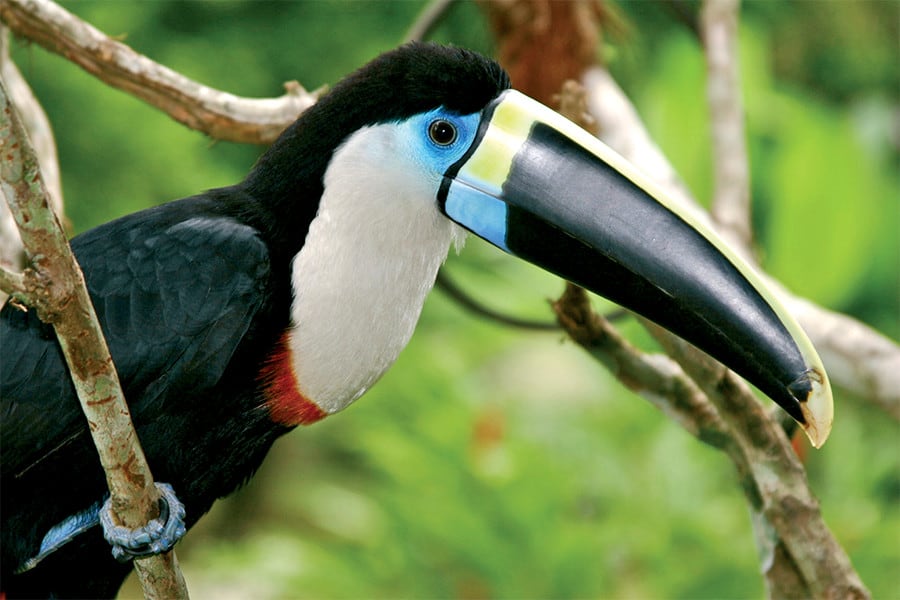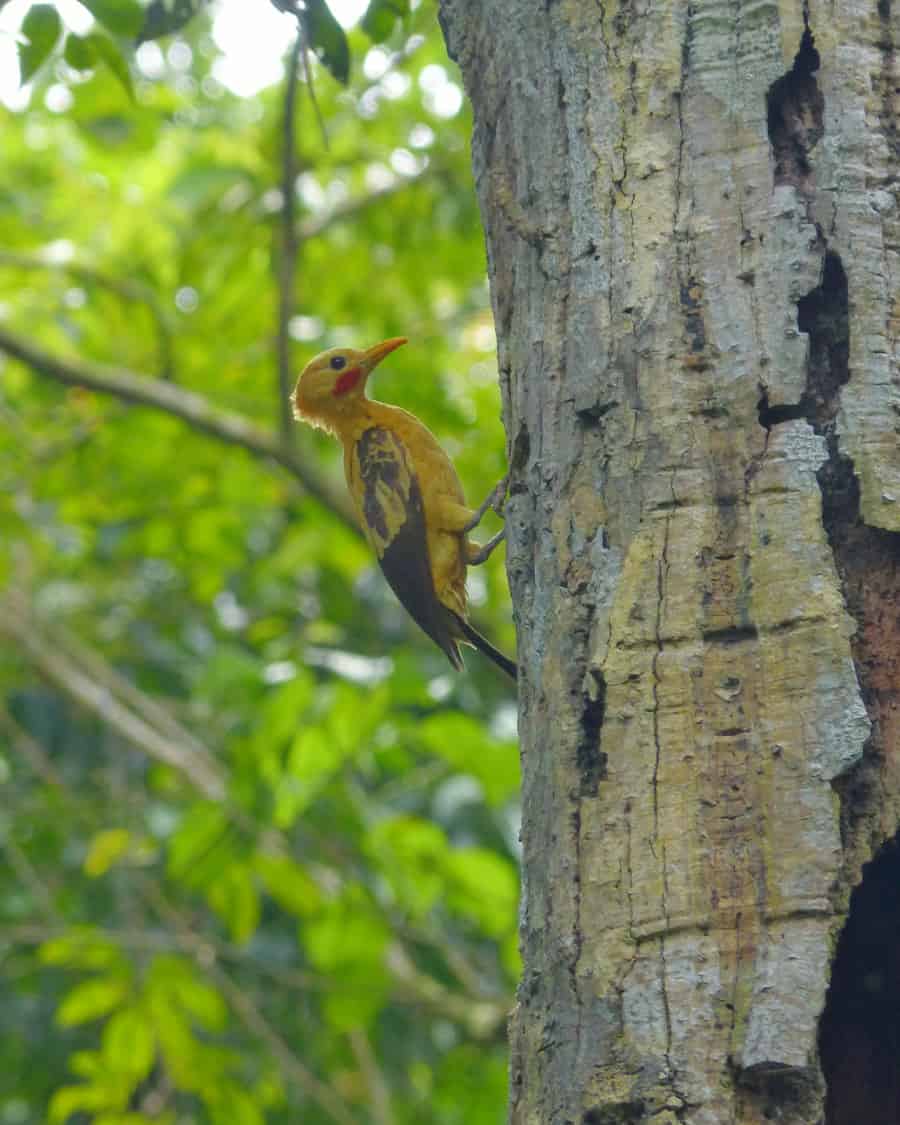
Bird Calls of the Amazon
At Aqua Expeditions, we’re proud to celebrate the biodiversity witnessed across our remote destinations. Our expeditions into the Peruvian Amazon – aboard Aqua Nera and Aria Amazon – take us to one of the top bird-watching destinations in the world.
The Pacaya-Samiria National Reserve in the Peruvian Amazon is a bird-lovers paradise, with over 440 recorded ornithological species. Avid bird watchers can participate in our small group excursions on Aqua Nera and Aria Amazon which usually take place in early mornings – the time of day in which birds are the most active foraging for food.
Unbeknownst to many, bird watching actually comes with many health benefits. The sounds of birdsong and rustling leaves immerses the mind in nature. This meditative state leads to a moment of stillness free of distraction. Many studies have shown how bird-watching and sustained exposure to nature can have a positive effect on mental health, lowering stress hormones, depression and anxiety, even improving cardiovascular disease and longevity.
Our expert wildlife guides are trained to spot and easily recognize these birds and their individual unique calls while on skiff excursions along the Amazon river and tributaries and jungle walks. In fact, George Dávila, one of our Amazon naturalist guides and ornithology experts, has the unique talent of imitating bird calls, a skill he learnt from his parents. Here are five of the exotic species you might see on one of our excursions.
Horned Screamer
Horned Screamers are the largest of the screamer family (measuring between 84-95 cm) including the Crested screamer and Northern screamer. As their name suggests, these are noisy birds whose loud sounds can be heard for hours up to 3km away. They perform three main calls: a call to alarm others of a predator, a greeting, and an intense trumpet that acts as distance call and morning alarm.
Found in the wetlands of South America, including the Peruvian Amazon riverbanks, they’re identified by their distinctive 15cm horn-like cartilage structure protruding from their head, reminiscent of that of the mythical unicorn. Unlike unicorns though, they’re monochromatic in color with a distinct white patch on their belly.
Those embarking on our Peruvian Amazon expeditions during the high water season between November to May can attempt to spot these birds engaging in a duet of their mating dance.
White-throated Toucan
Probably the most well-known bird on this list, the white-throated toucan does not fail to impress travelers exploring the Amazon. Not a stranger to the public eye, this bird is the mascot, Toucan Sam, for Keellog’s Froot Loops cereal, and is even a familiar character in popular children’s shows such as Dora the Explorer and Pokemon.
A conspicuous bird, it’s large in size (up to 60 cm) and has vibrant colors — its iconic huge bill has a yellow tip and connects with blue bare skin near the eyes. As their name implies, their beautiful black plumage has a signature patch of white at the throat and chest with a red border line below.
It is fairly easy to spot a toucan in the rainforest, mostly due to its loud, distinctive sound, comprising a series of yelps. These are social birds who live in small groups and emit different calls to communicate with each other, for example to indicate warnings or for mating.
Oriole Blackbird
This vividly yellow bird with black wings, tail and back, is a medium-sized (30cm) species. They have brown eyes surrounded by black bare skin, as well as black markings below the beak.
Oriole Blackbirds are commonly found in open habitats near rivers including riverbanks, marshes, pastures, and similar habitats of low altitude in Northern South America. This species flies in pairs or small flocks. Foraging mainly on the ground, they feed on fruits and tiny creatures such as caterpillars, earthworms, winged insects, and small frogs.
These eye-catching birds emit loud sounds, scratchy calls which are usually delivered from the top of a tree or while flying. The nasal screech is said to be similar to the sound of a gate with rusty hinges. Hear it for yourself on our jungle excursions aboard Aqua Nera or Aria Amazon.
Cream-coloured Woodpecker
Its unique pale-yellow plumage with a raised crest and brown wings makes this endearing woodpecker stand out from the crowd. Bird watchers will be able to distinguish the males because of their red malar stripe that gives an illusion of them blushing.
The cream-coloured woodpecker is found mainly in the seasonally flooded swamp forests of South America. They can be often seen pecking at termite or ant nests on trees, foraging alone or in small groups low in trees or in the ground.
Cream-coloured woodpeckers utter a distinctive high-pitched call with a lower pitch in the last note. While interacting with other species it also makes a “kiu-kiu-kiu-kiu” sound which is often repeated. Only around 24-26 cm in size, this ivory bird may be difficult to spot but our expert naturalist guides will be around to assist.
Capped Heron
This stunning bird is a rare find and will mesmerize any bird watcher longing to spot unique species in the Amazon. No other in its family has the unique paddlepop combination of a sky-blue beak and face (which becomes brighter during breeding season), cream-colored feathers on neck and body, pale gray back and wings and of course, its black cap.
The capped heron is widespread from eastern Panama to South Brazil, almost exclusive to the Amazon Basin. This solitary heron feeds mostly on fish and is very territorial. While hunting it will stand in a crouched position and then introduce its bill into the water in a rapid motion to catch its prey.
Capped herons are shy and quiet birds and are not as outspoken as others on this list — on display, they perform a series of low-pitched sounds. It may also utter honks and guttural croaks. It’s one of the least known species in its family (Ardeidae) and we still have a lot to learn and discover with regards to its biology, habits, population density, and interactions.
Excited to catch sight of some of these incredible winged creatures? Talk to our expedition consultants on taking a trip down the Amazon River on our world-class Aqua Nera and Aria Amazon.









